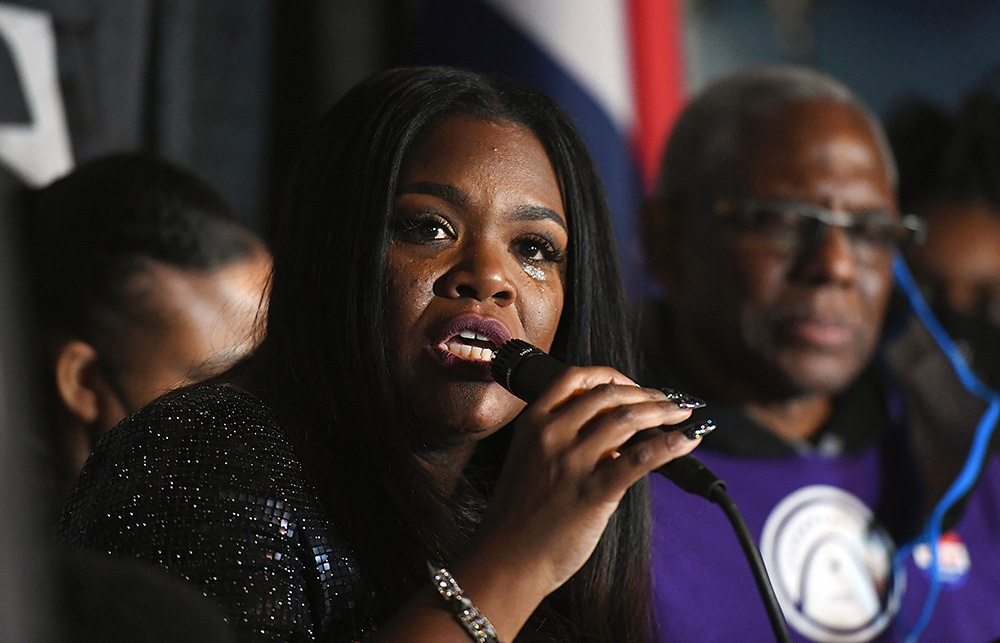
2020年,女性在美国国会的选举中取得了重要进步。
贺锦丽(Kamala Harris)将成为美国第一任女性副总统,同时,也是第一位有色人种副总统。今年,以亚历山大·奥卡西奥·科尔特斯、伊尔汗·奥马尔、艾亚娜·普莱斯利和拉希达·特莱布这四人组成的“小分队”为代表,有色人种女性在国会选举中表现不凡,节节获胜,备受瞩目。新墨西哥州所有竞选众议院席位的有色人种女性全部胜选。科里·布什将担任密苏里州的第一位黑人女议员。在第117届国会中,印第安女性的数量将创下历史纪录。
共和党中的女性也备受关注,有人将2020年称为共和党“属于女性的一年”。
2020年的美国总统大选是一个重要的里程碑:竞选国会议席的女性候选人数量、当选为众议院议员的女性的数量都达到创纪录的历史新高。但是,这些成就虽然有意义,却仍然远不足以实现代议制民主的目标。
罗格斯大学美国女性与政治中心(Center for American Women and Politics at Rutgers University)的报告显示,女性在众议院席位中的比例将仅从23.2%增加到25.5%。在参议院,由于玛莎·麦克萨利败给了亚利桑那州的民主党人对手马克·凯利,女性所占席位的比例将有所减少。
有色人种女性的数量仅占众议院的10%,参议院的4%;在贺锦丽当选副总统后,她原先在参议院的席位就空了出来,而如果候补的并非有色人种女性,则她们的比例将减少到3%。只有24名共和党女性当选为众议院议员——而这已经创下历史新高,其中还只有两位是有色人种。那“创纪录”的印第安女议员人数又有多少呢?只有三位。
这些数字并不足以为人称道。
女性占美国人口总数的51%,但在国会中所占的席位却从未超过25%。这让美国在“女性代表在立法机关中所占席位”的排名上不仅远落后于西欧,还远远落后于许多发展中国家。
长期以来,女性议员在美国国会中的比例都严重偏低,而这会导致很多问题。首先,研究表明,女议员会将代表女性权益的政策放在首位,而有色人种的女议员更在其中起到了重要作用。当女性在美国国会中的席位依然很少时,就很难说她们的权益和政策倾向得到了充分体现。
其次,女性的领导权在应对疫情危机方面至关重要。女议员往往会号召大家支持那些有助于渡过疫情的政策,例如为公众提供医保和社会援助。除了遏制疫情传播外,女议员还会优先考虑到疫情的社会后果。有色人种女性议员表示,她们已经努力满足了那些遭受重创的社区的需求。
第三,研究发现了女议员与政府信用之间的联系。在两性的刻板印象中,女性是诚实而不易腐败的,再加上历来被排斥在政治之外,就使得她们似乎成为“政治场”这片声名狼藉的(且由男性主导的)领域里的另一种选择。十多年来,人们对美国政府的信任度一直在下降,因此增加女性议员的人数,很可能有助于改善这一状况。
最后,即便男女政客在行为上没有什么差别,让女性在政府机构中任职对民主合法性来说也至关重要。毕竟,如果一个民主政府未能反映出它所代表的人民的多样性,那么这个政府将如何代表民主呢?
世界上已经有很多人认识到,女性参政人数过少是有问题的,也已经采取具体措施加以改善。目前,全球有130多个国家在其政府或自愿性政党的成员中,采用某种形式的性别配额。
围绕政治中性别平等的讨论已经在全球范围内展开。例如2018年,墨西哥就在国家和大多数州的立法机关中实现了性别平等。卢旺达和玻利维亚的立法机关目前也有超过50%的女性。
美国还需要向这些正面案例学习很多东西。增加女性在国会、州政府和地方政府中的席位,不仅关系到女性的利益和民主代表权,而且关系到缓解疫情、恢复人们对政府的信任,以及实现代议制民主的理想。
肯德尔·D·芬克是亚利桑那州立大学政治学系的助理教授。她的研究领域包括女性的平等和政治代表权。(财富中文网)
编译:陈聪聪
2020年,女性在美国国会的选举中取得了重要进步。
贺锦丽(Kamala Harris)将成为美国第一任女性副总统,同时,也是第一位有色人种副总统。今年,以亚历山大·奥卡西奥·科尔特斯、伊尔汗·奥马尔、艾亚娜·普莱斯利和拉希达·特莱布这四人组成的“小分队”为代表,有色人种女性在国会选举中表现不凡,节节获胜,备受瞩目。新墨西哥州所有竞选众议院席位的有色人种女性全部胜选。科里·布什将担任密苏里州的第一位黑人女议员。在第117届国会中,印第安女性的数量将创下历史纪录。
共和党中的女性也备受关注,有人将2020年称为共和党“属于女性的一年”。
2020年的美国总统大选是一个重要的里程碑:竞选国会议席的女性候选人数量、当选为众议院议员的女性的数量都达到创纪录的历史新高。但是,这些成就虽然有意义,却仍然远不足以实现代议制民主的目标。
罗格斯大学美国女性与政治中心(Center for American Women and Politics at Rutgers University)的报告显示,女性在众议院席位中的比例将仅从23.2%增加到25.5%。在参议院,由于玛莎·麦克萨利败给了亚利桑那州的民主党人对手马克·凯利,女性所占席位的比例将有所减少。
有色人种女性的数量仅占众议院的10%,参议院的4%;在贺锦丽当选副总统后,她原先在参议院的席位就空了出来,而如果候补的并非有色人种女性,则她们的比例将减少到3%。只有24名共和党女性当选为众议院议员——而这已经创下历史新高,其中还只有两位是有色人种。那“创纪录”的印第安女议员人数又有多少呢?只有三位。
这些数字并不足以为人称道。
女性占美国人口总数的51%,但在国会中所占的席位却从未超过25%。这让美国在“女性代表在立法机关中所占席位”的排名上不仅远落后于西欧,还远远落后于许多发展中国家。
长期以来,女性议员在美国国会中的比例都严重偏低,而这会导致很多问题。首先,研究表明,女议员会将代表女性权益的政策放在首位,而有色人种的女议员更在其中起到了重要作用。当女性在美国国会中的席位依然很少时,就很难说她们的权益和政策倾向得到了充分体现。
其次,女性的领导权在应对疫情危机方面至关重要。女议员往往会号召大家支持那些有助于渡过疫情的政策,例如为公众提供医保和社会援助。除了遏制疫情传播外,女议员还会优先考虑到疫情的社会后果。有色人种女性议员表示,她们已经努力满足了那些遭受重创的社区的需求。
第三,研究发现了女议员与政府信用之间的联系。在两性的刻板印象中,女性是诚实而不易腐败的,再加上历来被排斥在政治之外,就使得她们似乎成为“政治场”这片声名狼藉的(且由男性主导的)领域里的另一种选择。十多年来,人们对美国政府的信任度一直在下降,因此增加女性议员的人数,很可能有助于改善这一状况。
最后,即便男女政客在行为上没有什么差别,让女性在政府机构中任职对民主合法性来说也至关重要。毕竟,如果一个民主政府未能反映出它所代表的人民的多样性,那么这个政府将如何代表民主呢?
世界上已经有很多人认识到,女性参政人数过少是有问题的,也已经采取具体措施加以改善。目前,全球有130多个国家在其政府或自愿性政党的成员中,采用某种形式的性别配额。
围绕政治中性别平等的讨论已经在全球范围内展开。例如2018年,墨西哥就在国家和大多数州的立法机关中实现了性别平等。卢旺达和玻利维亚的立法机关目前也有超过50%的女性。
美国还需要向这些正面案例学习很多东西。增加女性在国会、州政府和地方政府中的席位,不仅关系到女性的利益和民主代表权,而且关系到缓解疫情、恢复人们对政府的信任,以及实现代议制民主的理想。
肯德尔·D·芬克是亚利桑那州立大学政治学系的助理教授。她的研究领域包括女性的平等和政治代表权。(财富中文网)
编译:陈聪聪
Women won key congressional races across the U.S. in 2020.
Kamala Harris will become the first woman, and person of color, to be Vice President. High-profile women of color won their election bids, including the four representatives—Alexandria Ocasio-Cortez, Ilhan Omar, Ayanna Pressley, and Rashida Tlaib—known as “The Squad.” New Mexico elected all women of color to its House delegation. Cori Bush will serve as the first Black congresswoman for Missouri. And the 117th Congress will boast a record number of Native American women.
Republican women are also in the spotlight, with some calling 2020 the “Year of the Woman” for Republicans.
The 2020 election has yielded important milestones, including record numbers of women candidates and an all-time high number of women elected to the House of Representatives. But these gains, while meaningful, are insufficient for meeting the goals of a representative democracy.
The Center for American Women and Politics at Rutgers University reports that women’s share of seats in the House of Representatives will increase from 23.2% to a mere 25.5%. In the Senate, women’s seat share will decrease following Martha McSally’s loss to Democratic challenger Mark Kelly in Arizona.
Women of color make up just 10% of the House and 4% of the Senate—and this would decrease to 3% if a woman of color isn’t selected for Harris’s vacated Senate seat. Only 24 Republican women were elected to the House—an all-time high—and just two of those are women of color. And that record-breaking number of Native American congresswomen? It’s only three.
These numbers aren’t very impressive.
Women make up 51% of the U.S. population but have never exceeded 25% of Congress. This sets the U.S. far behind not only Western Europe, but also much of the developing world in rankings of women’s legislative representation.
Women’s persistent underrepresentation is problematic for many reasons. First, research shows that congresswomen prioritize women’s policy interests and congresswomen of color play a large role in keeping women’s interests on the agenda. It’s hard to say that women’s interests and policy preferences are fully represented in the U.S. when so few women have a seat at the table.
Second, women’s leadership matters for the COVID-19 crisis. Women elected officials tend to champion the types of policies and services that will support everyone through the pandemic, like access to health care and social assistance. In addition to curbing the virus’s spread, women politicians also prioritize the pandemic’s social consequences, and women of color have shown that they are tuned in to the needs of their hard-hit communities.
Third, research identifies a link between women’s representation and trust in government institutions. Gender stereotypes of women as honest and less corruptible, combined with women’s historic exclusion from politics, make women appear to be a viable alternative to the discredited (male) establishment. Trust in the U.S. federal government has been on the decline for over a decade, so increasing women’s representation might help improve this.
Finally, even if women politicians behaved the same as men politicians, their presence in governing institutions matters for democratic legitimacy. After all, how representative is a democratic government if it fails to mirror the diversity of the people it is meant to represent?
Much of the world has acknowledged that women’s underrepresentation is problematic and has taken concrete steps to ameliorate this. Over 130 countries worldwide now use some form of gender quota law for their governments or voluntary political party quotas.
Globally, the political discourse is converging around gender parity. Mexico, for example, reached gender parity in the national legislature and most of its state legislatures in 2018. Rwanda’s and Bolivia’s legislatures currently exceed 50% women.
The U.S. has much to learn from these examples. Increasing women’s presence in Congress, as well as in state and local governments, matters not only for women’s rights and representation, but also for mitigating the COVID-19 pandemic, restoring trust in government, and fulfilling the ideals of a representative democracy.
Kendall D. Funk is an assistant professor of political science at Arizona State University. She researches women’s equality and political representation.






